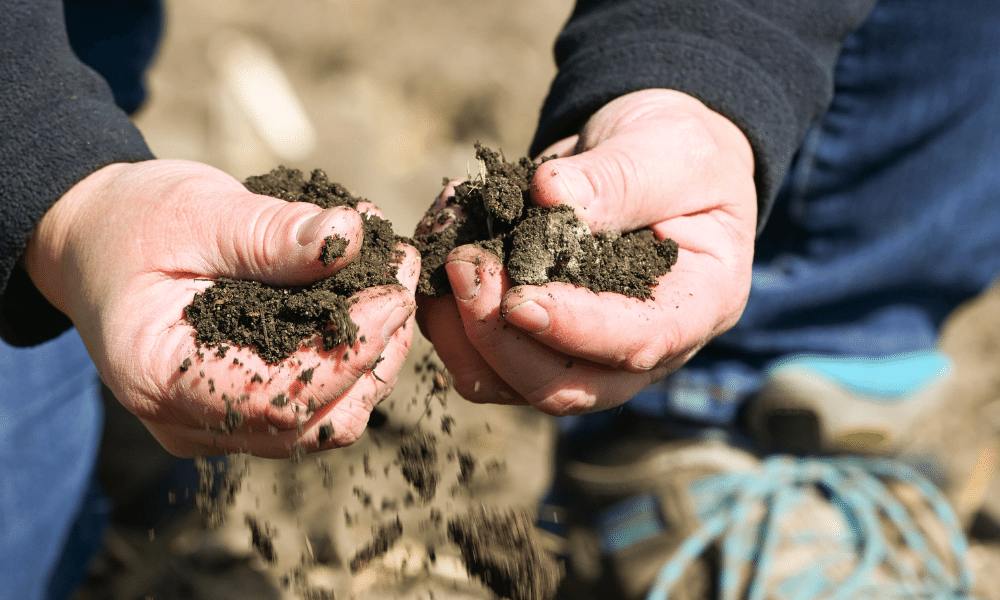
Multiple conservation efforts on April Hemmes’ farm in north central Iowa help maintain and build soil health. (Photo: Iowa Soybean Association)
Regenerative Ag: A systems approach to soil health
May 5, 2021 | Bethany Baratta
Regenerative agriculture may seem like a buzzworthy, complicated phrase, but Roger Wolf says it’s something the Iowa Soybean Association (ISA) has been helping farmers define and achieve for decades.
“Regenerative ag is a fundamental start of focusing on soil health,” says Wolf, director of the ISA’s Research Center for Farming Innovation (RCFI).
It’s a systems approach of thinking about soil health and the practices that encourage carbon response. It’s then balancing soil health and water quality.
“Thinking about water and soil balance is important primarily because water has such a big impact on yield,” Wolf says.
Soils are too dry or too wet negatively impact crops, so looking at how to achieve a balance with water is also part of this systems approach to soil health.
“It’s much broader than picking a practice, now we’re looking at how you pick a practice and get multiple benefits,” Wolf says.
One example is ISA’s approach to transforming drainage. What impact does drainage system have on water quality and the loss of nutrients? If we capture water on the landscape and irrigate it back, how does that change the cropping system?
Combining practices and research makes it all come together, Wolf says.
“It’s a data-driven approach and applying a scientific process to understand how systems respond.”
Expanding efforts
Regenerative ag and the systems approach to water and soil health isn’t a new concept, says April Hemmes, an ISA director from Hampton.
“I don’t know any farmer who doesn’t want healthier soils,” Hemmes says.
When her father and grandfather farmed the land in north central Iowa, pasture rotation and strategically planting alfalfa on side hills or places where corn didn’t grow well were ways to preserve soil without impacting water quality.
Today, she implements practices that have the same goals. Hemmes plants cover crops on some of her acres, has natural grass buffer strips to protect water quality, and no-till fields to keep soil disturbance at a minimum.
“Leaving the crop residue out there doesn’t harm anything, in fact, I’m building soil health and organic matter,” Hemmes says.
Having served on her local board as a Franklin County Soil and Water commissioner the last 25 years, she’s thinking about regenerative practices not only on her farm, but in her county, too.
Evaluating her practices and production led Hemmes to think differently about a challenging four acres that produced crops in just two of 25 years of farming. The piece is close to a creek, has a steep dip, but lies lower than the creek itself.
She converted the four acres to a wetland, providing habitat and adding to the conservation efforts on her fourth-generation farm.
Explaining conservation benefits
One of the latest tools developed by ISA RCFI’s analytics team is helping farmers demonstrate how adding cover crops to their system may provide opportunities and benefits. The Cover Crop Economic Simulator tool is designed for farmers, landowners and anyone else interested in measuring the environmental and economic outcomes of cover crops.
ISA member Pat Murken from Story City realized the benefits of this new tool when presenting a business case to his landowners, as he does each year.
“For the past 11 years, I’ve told them about the benefits of cover crops, but I didn’t specifically have the economics worked out to show them,” Murken says. “By plugging my information into the simulator tool, I’m able to show the income opportunities through cover crops on those farms.”
There are cover crop tools available from other entities, but the ability to use aggregated figures or custom numbers makes ISA’s tool unique. Plus, ISA’s simulator shows users the other benefits cover crops provide that are difficult to put a price on, such as increased pollinator population, and benefits for future generations.
Murken says he’s realized increased soil stability and nutrient availability year-over-year. The 2020 crop year showed these benefits.
His fields were in the path of the August 2020 derecho. The storm decimated crops across the state. Though one-third of his corn stalks were broken or downed as a result, he was still able to produce a bumper corn crop.
“Thanks to cover crops and the positive condition of the soil, we averaged over 200 bushels on the acres with 35% of corn stalks broken,” Murken says.
Healthier soils mean he’s been able to use less nitrogen. Three years ago, he dropped nitrogen usage by 10 pounds per acre. This year, he’s decreasing nitrogen applications by an additional 15 pounds per acre.
Leveraging strengths
Leveraging farmers’ in-field practices with data and decision support tools help expand conservation efforts and furthers the work in the regenerative ag space, Wolf says.
“As we continue to scale up nutrient reduction practices, we’ll continue to see this need of capturing multiple values, whether that’s adding diversity to the rotation or leveraging the symbiotic relationship of livestock and crops,” Wolf says. “It’s fundamentally going back to leveraging the productive strengths of the soil and thinking about movement and management of water and loss of nutrients. If we can keep more nutrients in the system, it creates more value for farmers.”
This story was originally published in the Spring 2021 issue of the Iowa Soybean Review.
Back